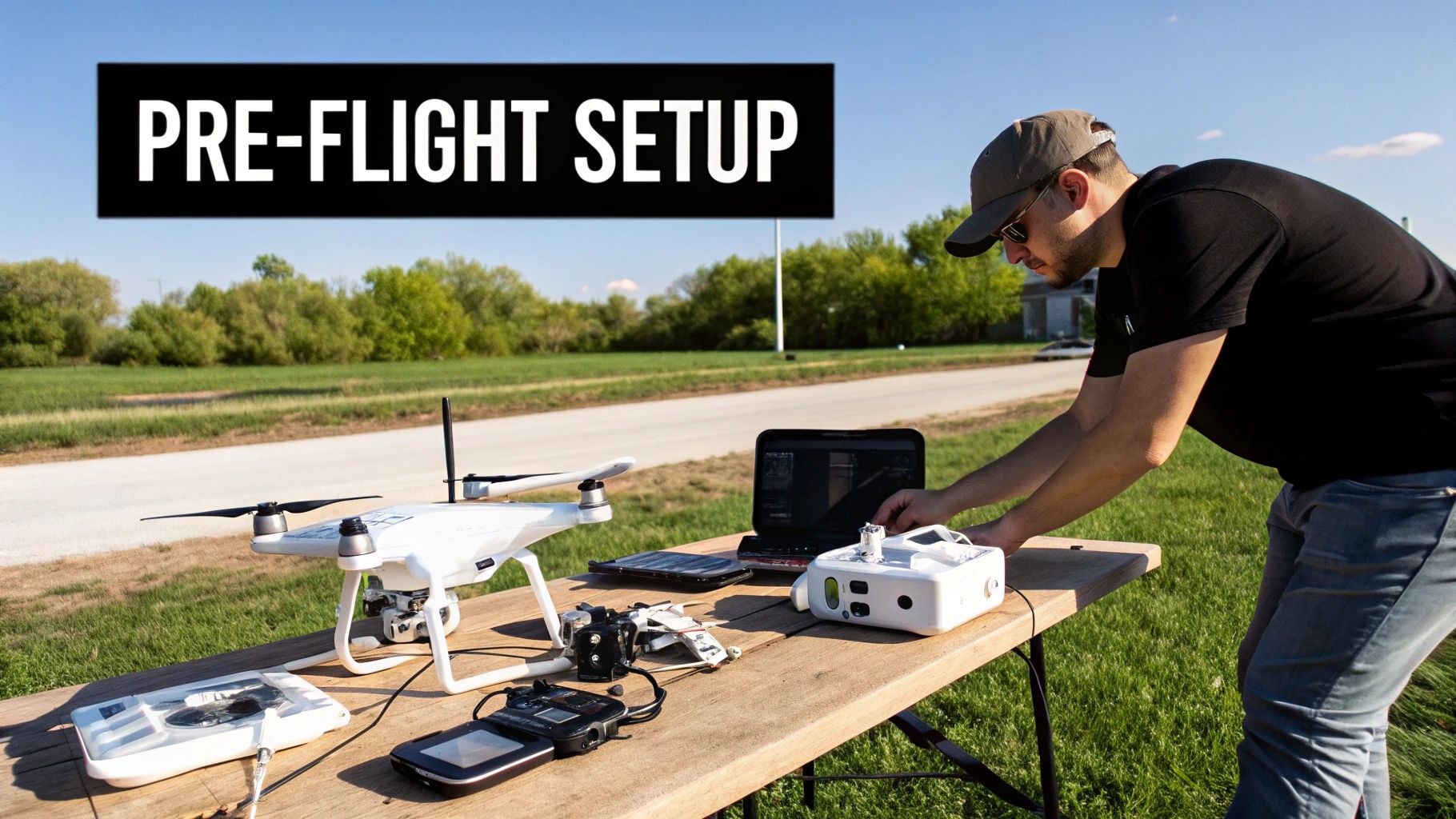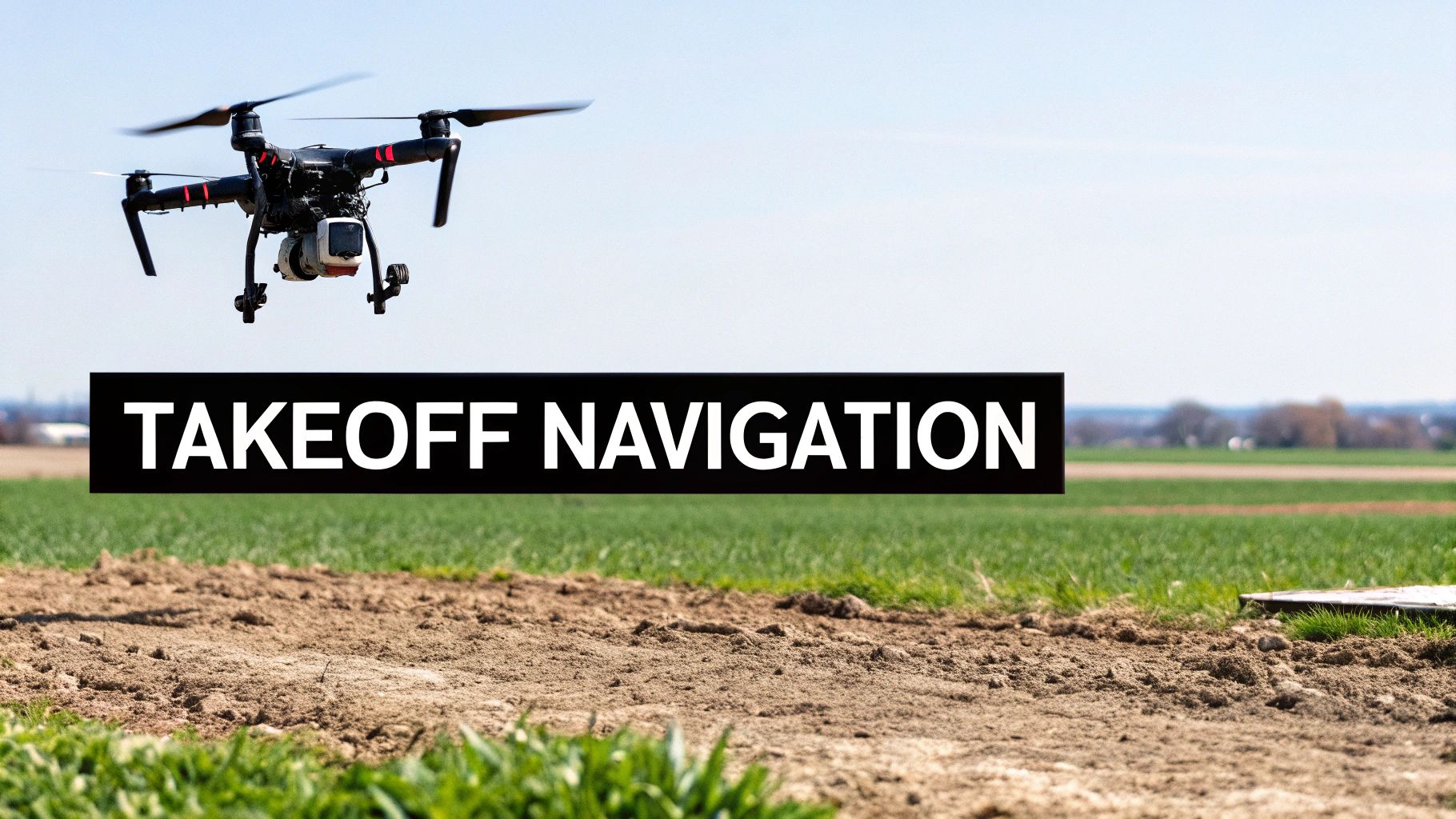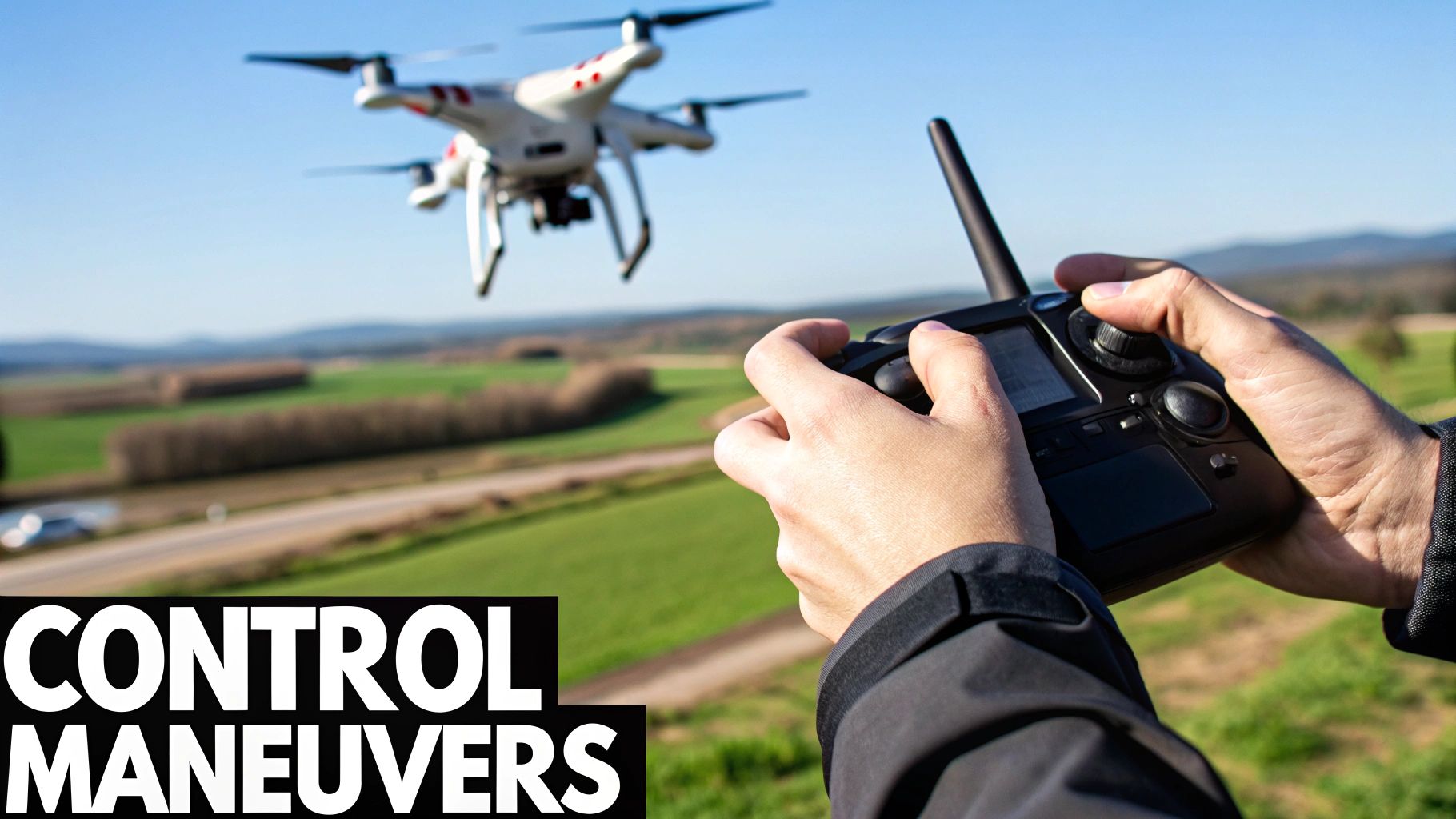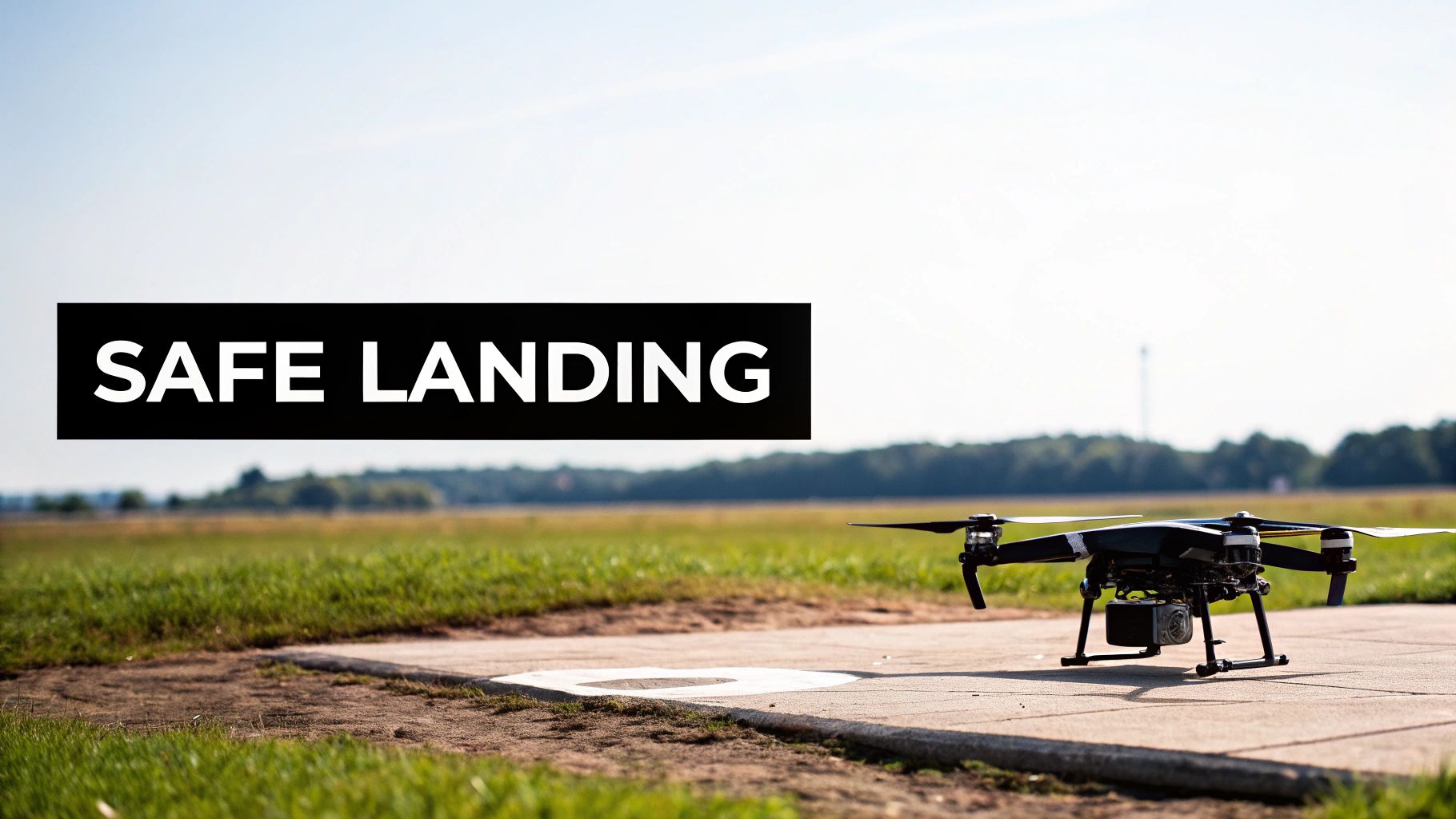How to Fly a Drone for Beginners: Get Started Today
- A.E. Williams
- Apr 10
- 11 min read
The Foundations of Drone Flight

Before taking off, understanding your drone's core components is essential. These parts work together to enable flight, and knowing their function is key to safe operation. This understanding starts with the remote controller, your primary interface for communicating with the drone. It's like the steering wheel and pedals of a car, giving you direct control.
Key Drone Components
Next, consider the propellers, generating the thrust needed for takeoff and maneuvering. These rotating blades are crucial for controlling altitude and direction. The motors power these propellers, converting battery power into rotational force. The motors work in concert, adjusting their speeds for precise movements.
The battery powers all onboard systems. Understanding battery life and charging is essential for flight planning and avoiding mid-air power loss. Lastly, the camera system captures aerial footage and photos. For beginners, controlling the camera's angle and settings is vital for capturing memorable moments.
Drone Types and Selection
Various drone types exist, each with a specific purpose. For beginners, multi-rotor drones (like quadcopters and hexacopters) are often recommended. These offer greater stability and are easier to control, making them ideal for learning. In fact, multi-rotor drones hold a 70.18% market share in the 2023 U.S. consumer drone market due to their user-friendliness.
The market is booming, projected to grow from USD 1,487.2 million in 2023 to USD 3,008.5 million by 2030. This represents a 10.6% Compound Annual Growth Rate (CAGR), highlighting the increasing popularity of drone technology. You can find more detailed statistics here: https://www.grandviewresearch.com/horizon/outlook/consumer-drone-market/united-states
When selecting your first drone, consider your budget and intended use. Start with a basic, reliable model to master fundamental flight skills. This approach builds confidence and experience without overwhelming you with complex technology. Choosing the right drone is a crucial first step.
Smart Pre-Flight Rituals That Prevent Disasters

Before embarking on a drone flight, taking the time for pre-flight preparation is essential for a positive experience. Just like planning a safe and memorable manta ray night snorkel experience, a thorough pre-flight check is crucial for safe and successful drone operations. This goes far beyond simply charging the battery; it's a comprehensive assessment that ensures everything is in perfect working order. These checks can save you from costly repairs and ensure you're flying responsibly.
Inspect Your Drone
Begin with a physical inspection of your drone. Pay close attention to the propellers, examining them carefully for any cracks, chips, or signs of damage. Even a small imperfection can impact flight stability.
Next, examine the body of the drone. Look for any loose parts or cracks. Ensuring all components are securely fastened is vital for safe operation.
Finally, inspect the battery. Make sure it's fully charged and free from any physical damage. Remember, battery health directly affects flight time and overall drone performance.
Understand Weather Conditions
Wind can be particularly challenging for beginners. Even a light breeze can have a significant impact on smaller drones. Before taking off, assess the wind speed and direction. Observe your surroundings for clues, like swaying trees or flags.
If the wind is too strong, postpone your flight. While this is a judgment call, it’s always best to err on the side of caution. Also, avoid flying in rain or snow. Moisture can damage the drone's sensitive electronics.
Calibrate and Configure
Calibration is crucial for ensuring your drone responds accurately to your commands. This process synchronizes the drone’s internal sensors with its position. Most drones have a built-in calibration feature, so consult your user manual. Specifically, calibrating the compass and IMU (Inertial Measurement Unit) helps maintain stability and orientation.
After calibration, configure essential safety features, especially return-to-home (RTH). This function automatically returns the drone to its launch point if connection is lost or the battery runs low. Setting up RTH correctly is essential for preventing loss of your drone.
A personalized pre-flight checklist reinforces these steps, making them habitual. The following table provides a solid starting point:
Pre-Flight Checklist for Beginners: A comprehensive checklist covering all essential checks and preparations before flying your drone
Item to Check | What to Look For | Why It's Important |
|---|---|---|
Propellers | Cracks, chips, or damage | Maintains flight stability |
Drone Body | Loose parts, cracks | Ensures structural integrity |
Battery | Charge level, physical condition | Provides adequate power and prevents mid-air failure |
Environment | Wind speed, obstacles, no-fly zones | Safeguards against collisions and legal issues |
Calibration | Compass, IMU | Ensures accurate drone response |
RTH | Activated and properly configured | Prevents loss of drone in emergencies |
Consistently following these pre-flight rituals minimizes the risk of accidents and helps you develop responsible drone piloting habits. Careful preparation allows you to focus on capturing stunning footage and exploring the sky safely.
Mastering The Controls: From Nervous to Natural

So, you're ready to pilot your drone? Let's explore the core of drone flight: the controls. Initially, the controller might seem complex. However, with the proper guidance, you'll become proficient quickly. We'll simplify each function – pitch, roll, yaw, and throttle – into manageable movements. This process focuses on developing muscle memory and understanding your drone's responsiveness.
Understanding Basic Drone Movements
Visualize your drone as an extension of your body. Pitch tilts the drone forward or backward, similar to nodding your head. This governs your forward and backward motion. Roll tilts the drone left or right, much like shaking your head. This controls sideways movement. Yaw rotates the drone horizontally, changing its facing direction, like turning your head to look over your shoulder. Lastly, the throttle controls vertical movement—up and down—like an elevator.
From Hovering to Maneuvering
Begin your practice with hovering. This involves maintaining a steady altitude and position, similar to balancing on a bicycle. It might feel unsteady at first, but practice builds proficiency. Many beginners overcorrect, resulting in jerky, destabilizing movements. Smooth, gentle inputs are essential.
Once you're comfortable hovering, try forward and backward movements using the pitch control. Maintain a consistent altitude while focusing on seamless transitions. Next, incorporate roll for lateral movement, practicing smooth turns and directional changes. Before every flight, remember your preflight checklist for drones. This ensures your drone is in optimal condition.
Combining Controls for Fluid Flight
As your skill develops, start combining controls. For example, practice moving forward while simultaneously yawing to change direction smoothly. Try flying in patterns, like circles or squares, to refine your control. This develops coordination and prepares you for more intricate maneuvers.
To help you understand the different controls and their impact on your drone's flight, let's look at the following table:
Drone Control Functions A breakdown of controller stick functions and the movements they produce
Control Stick | Movement | Effect on Drone | Common Mistakes |
|---|---|---|---|
Pitch (Forward/Backward) | Tilts drone forward and backward | Moves drone forward or backward | Overcorrecting, leading to jerky movements |
Roll (Left/Right) | Tilts drone left and right | Moves drone sideways (left or right) | Sudden inputs, causing instability |
Yaw (Rotate) | Rotates drone horizontally | Changes the direction the drone is facing | Rotating too quickly, losing orientation |
Throttle (Up/Down) | Increases or decreases rotor speed | Controls drone's altitude (up or down) | Ascending or descending too rapidly |
This table summarizes the core controls and their effects, emphasizing the importance of smooth inputs for stable flight. Mastering these fundamentals is key to avoiding common mistakes.
The drone industry is experiencing significant growth. Shipments are projected to increase from 2.4 million units in 2023 to over 3.1 million by 2025. For more insights into this trend, find more detailed statistics here. This growth reflects the increasing popularity of drones for both recreational and professional purposes.
Mastering these controls is the foundation for everything that follows, from capturing breathtaking aerial footage to exploring the full potential of your drone. Remember, practice makes perfect!
Navigating Drone Laws Without The Confusion

Understanding drone regulations is just as important as mastering the controls. The legal side of flying can feel overwhelming for new pilots. But getting a handle on the rules ensures safe, legal, and responsible flights. This knowledge helps avoid penalties and builds a positive image for the drone community.
Drone Registration: When and How
Many beginners wonder if they need to register their drone. In numerous countries, including the U.S., drones weighing over a certain amount (typically 0.55 lbs or 250 grams) must be registered. This process is usually simple, requiring a small fee and online registration with the proper aviation authority, such as the FAA in the United States. Think of it like a license plate for your drone.
Registration helps authorities track drones and enforce regulations.
Understanding No-Fly Zones
No-fly zones are designated areas where drones are prohibited. These often include airports, military bases, and other sensitive locations. Flying in these restricted areas can lead to significant fines or even criminal charges. It’s crucial to research and understand the no-fly zones in your local area before every flight.
Many drone apps offer real-time airspace restriction information, making compliance easier.
Respecting Privacy: Capturing Footage Legally
Drones with cameras raise important privacy concerns. Capturing amazing aerial footage is a big part of the fun, but respecting others' privacy is paramount. Avoid flying over private property without permission and be careful where you film. Filming someone in their backyard without their consent can lead to legal and ethical problems.
Always prioritize privacy and get permission when in doubt. This helps build good relationships between drone pilots and the community.
The Growing Commercial Drone Industry
The commercial drone industry is booming. Driven by advancements in technology and evolving regulations, the global market was valued at about USD 43.4 billion in 2023. Projections show this market reaching over USD 1,445.80 billion by 2034, growing at a 37% CAGR. Learn more about this growth: https://www.precedenceresearch.com/commercial-drone-market. These opportunities highlight the increasing importance of understanding drone laws.
Checking for Temporary Flight Restrictions
Always check for Temporary Flight Restrictions (TFRs) before each flight. These restrictions can be put in place for many reasons, such as special events or emergencies. TFRs are often announced on short notice, so checking right before takeoff is critical. Ignoring a TFR can have serious consequences.
Many resources, including websites and apps, provide up-to-date TFR information.
Recreational vs. Commercial Flight
Understanding the difference between recreational and commercial drone flight is key. Flying for fun or personal use is generally recreational. Using a drone for business purposes, like real estate photography, is commercial. Commercial drone operation often requires additional certifications and permits.
Operating in the correct category ensures you comply with the specific regulations for your type of flight. This can include different licensing requirements and operational limitations. By understanding these rules, you can enjoy your drone while staying within legal boundaries.
Avoiding The Crashes That Haunt New Pilots
Crashes, unfortunately, are a reality in the drone world. However, learning from others' experiences can dramatically reduce your risk. This section will help you build a strong safety foundation, giving you the tools to handle tricky situations and keep your drone flying high.
Safe Distances: Your Drone's Personal Space
Maintaining safe distances from people, vehicles, and structures is absolutely critical. This buffer zone gives you time and space to react and maneuver. Experienced pilots understand this, treating safe distances as essential rules, not optional guidelines.
People: Give people a wide berth, especially over crowds. A sudden gust of wind could mean the difference between a near miss and an accident.
Vehicles: Moving vehicles present a dynamic challenge. Keep a significant distance and try to anticipate their movements.
Structures: Buildings, trees, and power lines are all potential collision hazards. Approach cautiously and allow ample room for maneuvering.
These recommended distances provide critical protection in unexpected situations.
Battery Management: Don't Run on Empty
Your drone's battery is its lifeblood. Understanding its limitations is essential for safe flights. Learn to spot these key warning signs of a low battery:
Reduced Flight Time: Shorter flight times than usual can signal a weakening battery. Consider replacing it.
Low Battery Warnings: Pay close attention to your controller's warnings and any on-screen indicators. Land promptly.
Rapid Altitude Loss: This is a critical warning sign. Land immediately if your drone begins to descend rapidly.
Treat your battery life like a car's fuel gauge. Don't push it to the limit. Landing with reserve power gives you time to respond to the unexpected.
Signal Interference: Keeping Your Connection Strong
A reliable signal between your drone and its controller is essential. Obstacles like trees and buildings can disrupt this connection. Here's what to keep in mind:
Open Areas are Best: Flying in open spaces reduces the risk of signal interference and improves visibility.
Watch Your Signal Strength: Your controller displays signal strength. Monitor this closely and avoid flying in areas with a weak signal.
Respect Your Drone's Range: Never exceed your controller's specified range. A lost signal can result in a flyaway.
If your signal begins to weaken, land as quickly as possible. Pushing the limits of your signal range invites disaster.
Emergency Procedures: When Things Go Wrong
Even the best-laid plans can go awry. Knowing how to react in an emergency can save your drone. Return-to-home (RTH) and manual recovery are your two primary emergency procedures.
RTH: If you lose signal or experience a critical battery drop, RTH automatically guides your drone back to its launch point. Ensure it's properly configured before each flight.
Manual Recovery: If your drone remains responsive, carefully regain control and land it in a safe area. This demands a clear head and precise control inputs.
Practice simulated emergencies in a safe, open space to build your reaction time and confidence. Developing situational awareness, the ability to anticipate potential problems, is key to responsible and enjoyable drone operation.
From Basic Flights to Breathtaking Footage
Once you've mastered the fundamentals of drone flight, it's time to elevate your aerial game. This section explores intermediate flight patterns, intelligent flight modes, and professional techniques to transform your videos from ordinary to awe-inspiring.
Cinematic Flight Patterns: Beyond the Basics
Think of your drone as an aerial camera platform. Going beyond simple vertical and horizontal movements unlocks a world of creative potential. Let's start with the orbit, a classic maneuver where your drone circles a point of interest, creating a dynamic and revealing shot. Imagine showcasing a stunning vista or historic landmark from every angle. This involves coordinating yaw and roll while maintaining a steady altitude and distance from your subject.
Next, we'll explore the reveal. As your drone ascends, it gradually unveils a wider perspective of the landscape below. This technique is perfect for showcasing dramatic vistas or large gatherings. Precise control over throttle and pitch is crucial for smooth, cinematic movement. Finally, the follow technique, where your drone tracks a moving subject, adds another layer of complexity and visual interest. This requires anticipating the subject's movements and making smooth adjustments to all controls, mimicking the movements of a skilled camera operator. This technique is ideal for capturing action shots of athletes, vehicles, or wildlife.
Intelligent Flight Modes: Your Automated Co-Pilot
Many modern drones boast intelligent flight modes, pre-programmed maneuvers that automate complex flight patterns. For example, Follow Me mode allows your drone to autonomously track your movements – perfect for capturing hands-free footage while hiking, biking, or engaging in other activities. DJI drones, for example, are well known for their advanced flight modes. Point of Interest mode lets you select a specific location for the drone to orbit, ideal for showcasing a landmark or architectural marvel. These intelligent modes free you to focus on camera settings and framing, resulting in more polished and professional results. However, even with these automated features, understanding core flight principles is essential for safe and efficient operation.
Telemetry and Troubleshooting: Data-Driven Flight
Professional drone pilots utilize telemetry data, the information transmitted from the drone to the controller, to analyze flights and refine their techniques. This data includes crucial information like altitude, speed, battery life, and GPS location. Analyzing telemetry can help you understand why a specific shot didn't turn out as planned, allowing for adjustments on future flights. For example, if your video appears shaky, reviewing the drone’s flight path can reveal moments of instability.
Troubleshooting in-flight issues demands quick thinking and a thorough understanding of your drone’s systems. A sudden drop in altitude, for instance, often indicates a low battery. This is where pre-flight checks become paramount. A fully charged battery and calibrated equipment can prevent many common problems.
Taking the Next Step: Professional Certification
For those aspiring to a career in drone operation, professional certification can open doors to a wealth of opportunities. Organizations like the FAA offer certification programs that validate your skills and knowledge. Building a compelling portfolio showcasing your best work is equally important. Consider specializing in areas like aerial photography, videography, or drone inspection.
By grasping these advanced concepts and diligently practicing your skills, you'll be well on your way to capturing breathtaking footage that truly showcases the power of drone technology. Ready to take your drone piloting to the next level? JAB Drone offers expert advice, comprehensive product reviews, and the latest news in the world of unmanned aerial vehicles.
Article created using [Outrank](https://outrank.so)
Comments